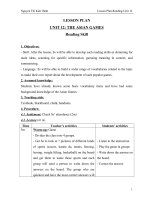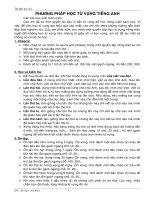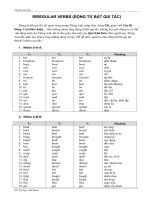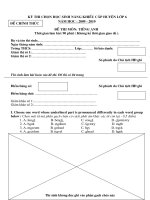Tài liệu Unit 5 Tieng Anh 11 chuan
Bạn đang xem bản rút gọn của tài liệu. Xem và tải ngay bản đầy đủ của tài liệu tại đây (461.06 KB, 16 trang )
Giáo án Tiếng Anh 11 (CTC) Theme: Education Topic: Illiteracy
Week: Period: Date:
UNIT 5 : ILLITERACY
Part A: Reading
I. Objectives
By the end of the lesson, Ss will be able to :
- Develop such reading micro-skills as scanning for specific ideas, identifying main ideas, and
identifying meaning in context.
- Use the information they have read to discuss illiteracy issues.
II. Materials
Textbook.
III. Anticipated problems
Ss may need to be provided vocabulary related to illiteracy so that thay can complete various learning
tasks.
IV. Procedure
Giáo viên: Đoàn Thò Vẹn Trinh- Tổ Anh Văn Trường Trung Học Phổ Thông Tân An1
Giáo án Tiếng Anh 11 (CTC) Theme: Education Topic: Illiteracy
Time Steps Work
arrangement
5’
WARM UP
- T writes the word “ILLITERACY” on the board.
- T divides the class into groups of 10 and introduces the game : The groups
should generate as many words related to this word as possible in 5 minutes.
- T divides the board into as many sections as the number of groups is. When
time is up, T calls on the representative of each group to come to the board and
write their list. Then T gets the whole class to count. Each correct word gets one
point. Which group has more points wins the game.
Suggested words:
Illiteracy rate, literacy rate, ethnic minority groups, poverty, mountainous areas,
reading and writing, eradicate illiteracy, illiterate, volunteer teacher, drop out,
primary education , compulsory education, low-income families
Group work &
whole class
7’
BEFORE YOU READ
- T gets Ss to work in pairs and try to make sense of the picture on page 56,
using the given prompts.
- T calls on some Ss to describe the picture. If Ss have difficulty talking about
the picture, T may elicit their answers by asking Qs and giving prompts. E.g:
What can you see in the picture? Who is the teacher ?
What about the Ss ? Where do you think the class is taking place ? etc. Ss
should give reasons for their answers.
- T checks with the class and asks Ss to guess what they are going to read about.
Suggested answers:
This is a class for ethnic minority children in a mountainous area. Perhaps the
class takes place in the morning because I can see the sunlight outside. The
children are listening very attentively to their teacher,who ia wearing a
soldier’s uniform. May be he’s a border soldier and works as a volunteer
teacher. There is only one textbook for each desk. It seems that this is a very
poor area because the class is poorly equipped and the children are wearing old
clothes.
- T introduces the topic of the lesson: illiteracy.
Pair work &
whole class
7’
WHILE YOU READ
Set the scene: You are going to read about education in mountainous areas and
do the reading tasks that follow.
TASK 1
- T gets Ss to read the passage silently and then do Task 1. T may write the
given phrases on the board (i.e family planning, farming techniques, etc.) and
asks Ss to go back to the passage to locate and read around these phrases so
that they can guess their meanings. For example, the phrase “illiteracy
eradication” found in lines 3 and 5 may refer to “teaching people to read and to
write”. Ss can understand this meaning thanks to the idea that 6 % of the
Individual
work,pair work
& whole class
Giáo viên: Đoàn Thò Vẹn Trinh- Tổ Anh Văn Trường Trung Học Phổ Thông Tân An2
Giáo án Tiếng Anh 11 (CTC) Theme: Education Topic: Illiteracy
population was able to read and write, so more work needs to be done to solve
this problem.
- T checks Ss’ understanding of the phrases by calling on some Ss to tell their
equivalents in Vietnamese.
- T checks the answers with the whole class and gives corrective feedback.
- T might want to get Ss to make sentences with important vocabulary items
such as “eradicate illiteracy”, “ farming techniques”.
5’
8’
Answers:
1. Phỉ cËp gi¸o dơc tiĨu häc
2. Héi khun häc ViƯt Nam
3. Xo¸ mï ch÷
4. Kü tht canh t¸c
5. KÕ ho¹ch ho¸ gia ®×nh
TASK 2
- T gets Ss to read the task requirement and do the task individually and then
find a peer to compare their answer with. If Ss can’t do the task without reading
the passage again, T might want to give them some time re-read the passage.
- T might also want to give Ss some strategies to find the main idea of the
passage:
+ Ss should read the text carefully and try to summarise it in the Ss’ own words.
+ Then Ss search through the list of main ideas provided in the task to find the
most suitable one,
+ Ss should make sure the main idea chosen sums up the entire text and not just
one idea with in it.
- T calls on some Ss to give their answers and asks other Ss to say whether they
agree or disagree.
- T gives feedback and the correct answer:
Answer: D
(Option A is too general; Options B & C are too specific)
TASK 3
- T checks if Ss can answer the comprehension Qs in TASK 3 without having to
read the passage again. If Ss can’t, T gets them to read the Qs carefully and
reminds them of the tips to do the task:
+ First, Ss should skim the 5 Qs to understand them. As Ss do this they:
* underline the key words to decide what information they need to find in the
text.
* look for Qs words like “why” which indicates Ss should read for specific thing
like a reason.
+ Then they should go back to the passage and locate the key words in the
passage.
+ Then they should read around the key words carefully to find the answer.
- T gets Ss to check answers with a peer.
- T calls on some Ss to write their answers on the board and ask them to explain
their choices.
Individual work,
pair work &
whole class
Giáo viên: Đoàn Thò Vẹn Trinh- Tổ Anh Văn Trường Trung Học Phổ Thông Tân An3
Giáo án Tiếng Anh 11 (CTC) Theme: Education Topic: Illiteracy
- T gives the correct answers:
Answer:
1. 94 % of the population (line 1, paragraph 1)
2. The campaign for illiteracy eradication (lines 1-2, para 2)
3. 600 in 2000 (line 3, para 2) and 800 in 2001 (lines 5-6, para 2)
4. They willingly / voluntarily spent their vocations teaching ethnic minority
illiterate people to read and write (lines 3-4, para 3)
5. illiteracy will soon be eradicated (lines 5-7, para 4).
10’
AFTER YOU READ
- T introduces the task : SS work in small groups of 3 or 4 and discuss the
question “How to help illiterate people in the disadvantaged areas to read and
write ?”
- T reminds Ss of some structures that can be used for giving suggestions. E.g
“perhaps we could” , “we might want to...”, “How about...”, etc.
- T provides Ss necessary vocabulary such as “poverty-stricken areas”, “sense
of responsibility and duty”, etc.
- T goes around to check and offer help.
- T calls on the groups to tell and explain their answers.
- T gives corrective feed back
Suggested Answer:
Mnay people (children and adults) in disadvantaged areas (e.g remote, poverty
– stricken areas) do not have a chance to go to school. To help them participate
in the society , along with other things (e.g. improvement their knowledge of
their rights and responsibility), we need to teach them how to read and write.
We could do this by:
+ Opening schools/ upgrading schools in these areas.
+ Sending teachers / volunteer teachers there
+ Buying book for children
+ Providing individual assistance to Ss
+ Give financial rewards to families that send their children to school
+ Training local people to be teachers who will help their own people.
Whole class
3’
WRAPPING UP
- T summarises the main ponts of thelesson.
- For homework, T asks Ss to learn by heart the new vocabulary and make
sentences with them.
Whole class
Week: Period: Date:
UNIT 5 : ILLITERACY
Part A: Speaking
I. Objectives
By the end of the lesson, Ss will be able to :
Giáo viên: Đoàn Thò Vẹn Trinh- Tổ Anh Văn Trường Trung Học Phổ Thông Tân An4
Giáo án Tiếng Anh 11 (CTC) Theme: Education Topic: Illiteracy
- Talk about schooling and literacy related problems
- Suggest solutions to these problems
II. Materials
Textbook, handouts, ...
III. Anticipated problems
Ss may have limited linguistic resources for discussion, so T should be ready to assist them
IV. Procedure
Time Steps Work
arrangement
5’
WARM UP
Matching game: (To teach vocabulary and lead Ss to the tape)
- T divides the class into small groups of 3-4 Ss. Then T distributes the following
hanhouts for Ss to do the matching task in their own groups. Which group
finishes first and has appropriate answers(*) will be the winner.
(*) The purpose of this task is to get Ss to think about school problems and there
should be no strictly right or wrong answers.
- T introduces the topic of the lesson: talking about school problems.
Match the photos with the problems they describe:
List of problems:
1. many ethnic minority children do not speak fluent Vietnamese, so they have
problems when doing their studies in this language.
2. Many children from low-income families drop out of school to earn their
living.
3. Many children live too far away from school and they walk miles to class and
back home everyday.
4. Classesn are large, so Ss are not given enough individual attention.
5. Some Ss cheat in exams. For example, they sit next to a friend who knows the
subject well and copy this person’s answers.
6. Mnay schools don’t have good library facilities and they rely on book
donations from patrons.
7. Many schools don’t have spacious playgrounds for children, so when some
groups are playing, there is little room left for other groups.
Suggested answers: 1. g 2. a 3. d 4. c 5. b 6. e 7. f
Group work &
whole class
7’
TASK 1
- T introduces the task and gets Ss to do it in pairs. T should encourage Ss to
guess the meanings of the new words, if any.
- T calls on a student to read out the answers.
- T checks with the class and gives corrective feedback. T should explain the
new words now or check Ss’ understanding by getting them to translate the
sentences into Vietnamese. T might also provide other similar expressions.
E.g:
Pair work &
whole class
Giáo viên: Đoàn Thò Vẹn Trinh- Tổ Anh Văn Trường Trung Học Phổ Thông Tân An5
Giáo án Tiếng Anh 11 (CTC) Theme: Education Topic: Illiteracy
Enforce a law / a regulation
Offer special tutoring lessons / private lessons
Provide transportation to schools / school buses
Set up an English speaking club / learning centres / study groups
Answers: 1. b-g 2. a-e 3. d-f 4. c-h 5. i-j
13’
TASK 2
- T introduces the task and calls on one or two pairs of Ss to read aloud the
sample dialogue. T corrects errors, if any.
- T elicits the structures that are used for asking for and giving suggestions. T
might want to write these structures on the board and gets Ss to do some
practice before putting them in groups and do the task. E.g:
Asking for opinion
What do you think we need to / could / should / might want to do ?
What do you think about ...?
What’s your opinion about ...?
What do you have in mind ?
Giving suggestions
May be we can...
We might want to...
Probably we should...
We could ...
- T puts Ss into groups of 3-4 and gets them to define the problems of their own
school and suggest as many solutions as possible. They can use the ones given
in Task 1 and add as many as they want to.
- T goes around to check and offer help.
- After checking that Ss have finished the task, T calls on different groups to
present the problems and solutions they have identified.
- T writes these ideas on the board as Ss talk. Then T elicits comments from the
class and provides feedback.
Pair work,
group work &
whole class
17’
TASK 3
- T introduces the task: Ss are going to work together to identify the problems
of their own classroom and offer solutions. T gets Ss to look at the given cues,
elaborate on them and elicits some more problems, of possible. T writes the
ideas on the board. E.g:
+ Class size: large class (over 50), so Ss don’t get enough individual attention
from teachers. Ss don’t feel close because they often work in their own groups
rather than work with the whole class.
+ Desks: not enough desks, so 3-4 share one and there is hardly enough space
for everyone.
+ Poorly equipped: no electric fan / aircon, lights, broken windows / doors, so
it’s dark and cold in winter and hot in summer, no learning facilities such as TV,
Overhead Projector, computers and so on, so T and Ss rely on textbooks and the
blackboard for the lesson.
- Then T puts Ss into groups of 3-4 and gets them to add more problems if they
Group work &
whole class
Giáo viên: Đoàn Thò Vẹn Trinh- Tổ Anh Văn Trường Trung Học Phổ Thông Tân An6









